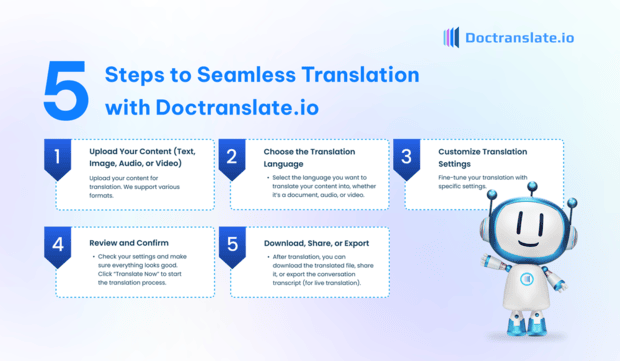Introduction
In today’s interconnected world, translating documents is vital. It helps break down language barriers and connect with people globally. Sharing information across different languages is key for business, education, and personal communication.
Translating from Polish to English opens up many opportunities. You can reach a wider English-speaking audience. This is essential for businesses expanding internationally or individuals sharing information abroad.
Whether you have reports, articles, or personal papers, accuracy is crucial. A good translation ensures your message is clear and understood as intended. Poor translation can lead to misunderstandings and loss of meaning.
DocTranslate.io offers a smooth solution for this task. It makes translating documents from Polish to English easy and effective. This guide will show you exactly how to do it step-by-step.
Step-by-Step Guide: Translating Documents from Polish to English with DocTranslate.io
Step 1: Upload Your Content
The first step is getting your document ready for translation. You need to upload the file containing your content. Make sure your document is in a format supported by the platform.
Supported formats include common types like PDF, DOCX, and others. DocTranslate.io is designed to handle various document files. Simply click the upload button to begin selecting your file.
Navigate to the location of your Polish document on your computer. Select the file you wish to translate into English. Confirm your selection to upload it to the platform.
This process is quick and user-friendly. Access the **Document Translate** page directly. Uploading your document is the starting point for achieving an accurate English version.
Step 2: Choose the Translation Language
After uploading your document, you must specify the languages. This tells the system what you want to translate from and to. It’s a critical step for accurate results.
First, identify the original language of your document. In this case, it is Polish. Select ‘Polish’ as the source language from the available options provided on the interface.
Next, choose the language you want your document translated into. For this guide, you will select ‘English’. This is your target language for the translation.
Selecting the correct language pair is essential. It ensures that the translation engine processes your text accurately. DocTranslate.io supports a wide range of languages, making it versatile for various needs.
Step 3: Customize Your Translation Settings
DocTranslate.io allows you to fine-tune the translation. You can adjust settings to match your specific requirements. This helps improve the quality and relevance of the output.
While translating documents, consider options like translation tone. Should it be formal, casual, or serious? Choosing the right tone ensures the translated document fits its intended purpose and audience.
You can also specify the domain or subject matter. Is your document legal, medical, or technical? Selecting a domain helps the system use appropriate terminology and context for better accuracy in the translation process.
Furthermore, you can utilize ‘My Dictionary’ feature. This allows you to add custom terms or phrases. Using My Dictionary ensures specific words are translated exactly as you prefer throughout the document, maintaining consistency and accuracy. You can explore settings on the **Document Translate** page.
Step 4: Review and Confirm
Before starting the translation, it’s good practice to review your settings. Quickly check the uploaded file name and the selected language pair. Ensure everything is correct to avoid errors.
Verify that ‘Polish’ is set as the source language. Confirm that ‘English’ is correctly chosen as the target language. Also, double-check any custom settings you applied, like tone or domain preferences.
This review step is simple but important. It helps confirm that the system is ready to process your request accurately. It prevents potential issues with the translation output.
Once you are satisfied with all the settings, you can proceed. Look for the ‘Translate Now’ or similar button. Clicking this button initiates the translation process for your document.
Step 5: Download, Share, or Export
After the translation is completed, your document is ready. DocTranslate.io provides options for accessing the translated content. You can choose the method that best suits your needs.
The most common option is to download the translated file. It will be in English, reflecting the content of your original Polish document. The format will typically match the input format, or you can choose a preferred output format if available.
Depending on the type of content and features used, you might have other options. For documents, downloading the translated file is the primary outcome. It gives you the English version of your document ready for use.
You can now use your translated document. Share it with colleagues, clients, or friends. The accurately translated English version helps you effectively communicate your message to a wider audience. Get started on the **Document Translate** page.

Conclusion
Translating documents from Polish to English is made simple with **DocTranslate.io**. By following these straightforward steps, you can efficiently convert your content. This process ensures accuracy and makes your information accessible to English speakers.
Using the platform means overcoming language barriers easily. You can confidently share your documents without worrying about translation quality. **DocTranslate.io** provides the tools for effective communication across languages.
Whether for personal or professional use, accurate document translation is invaluable. It expands your reach and opens doors to new opportunities. The steps outlined in this guide lead you to seamless translation results.
Don’t let language differences limit your communication. Start translating your Polish documents today and connect with a global audience. Experience the ease and efficiency of **DocTranslate.io**. Visit the site to begin your translation journey or revisit the **Step-by-Step Guide**.


Leave a Reply